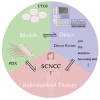Advancements in the Understanding of Small-Cell Neuroendocrine Cervical Cancer: Where We Stand and What Lies Ahead
- PMID: 38793044
- PMCID: PMC11122604
- DOI: 10.3390/jpm14050462
Advancements in the Understanding of Small-Cell Neuroendocrine Cervical Cancer: Where We Stand and What Lies Ahead
Abstract
Small-cell neuroendocrine cervical carcinoma (SCNCC) is a rare yet aggressive gynecological malignancy associated with dismal clinical outcomes. Its rarity has led to a limited number of retrospective studies and an absence of prospective research, posing significant challenges for evidence-based treatment approaches. As a result, most gynecologic oncology centers have limited experience with this tumor, emphasizing the urgent need for a comprehensive review and summary. This article systematically reviews the pathogenesis, immunohistochemical and molecular characteristics, prognostic factors, and clinical management of gynecologic SCNCC. We specifically focused on reviewing the distinct genomic characteristics of SCNCC identified via next-generation sequencing technologies, including loss of heterozygosity (LOH), somatic mutations, structural variations (SVs), and microRNA alterations. The identification of these actionable genomic events offers promise for discovering new molecular targets for drug development and enhancing therapeutic outcomes. Additionally, we delve deeper into key clinical challenges, such as determining the optimal treatment modality between chemoradiation and surgery for International Federation of Gynecology and Obstetrics (FIGO) stage I phase patients within a precision stratification framework, as well as the role of targeted therapy within the homologous recombination (HR) pathway, immune checkpoint inhibitors (ICIs), and prophylactic cranial irradiation (PCI) in the management of SCNCC. Finally, we anticipate the utilization of multiple SCNCC models, including cancer tissue-originated spheroid (CTOS) lines and patient-derived xenografts (PDXs), to decipher driver events and develop individualized therapeutic strategies for clinical application.
Keywords: molecular characteristics; pathogenesis; small-cell neuroendocrine carcinoma; treatment; uterine cervix.
Conflict of interest statement
The authors declare no conflicts of interest.
Figures

Similar articles
-
A Rare Case of Small-Cell Neuroendocrine Cancer of the Cervix: An Unexpected Diagnosis.Cureus. 2023 Jan 20;15(1):e34006. doi: 10.7759/cureus.34006. eCollection 2023 Jan. Cureus. 2023. PMID: 36811044 Free PMC article.
-
Small cell neuroendocrine carcinoma of the cervix: Analysis of prognostic factors and patterns of metastasis.Gynecol Oncol Rep. 2022 Aug 4;43:101058. doi: 10.1016/j.gore.2022.101058. eCollection 2022 Oct. Gynecol Oncol Rep. 2022. PMID: 35967833 Free PMC article.
-
The impact of neo/adjuvant treatment choices on prognosis for surgically treated small-cell neuroendocrine carcinoma of the cervix.Neoplasma. 2024 Feb;71(1):70-76. doi: 10.4149/neo_2023_230802N404. Epub 2024 Jan 12. Neoplasma. 2024. PMID: 38215035
-
Small cell neuroendocrine carcinoma of the cervix: From molecular basis to therapeutic advances.Biomed J. 2023 Oct;46(5):100633. doi: 10.1016/j.bj.2023.100633. Epub 2023 Jul 17. Biomed J. 2023. PMID: 37467967 Free PMC article. Review.
-
Small cell carcinoma of the gynecologic tract: a multifaceted spectrum of lesions.Gynecol Oncol. 2014 Aug;134(2):410-8. doi: 10.1016/j.ygyno.2014.05.017. Epub 2014 May 27. Gynecol Oncol. 2014. PMID: 24875120 Review.
Cited by
-
Advances in cervical cancer: current insights and future directions.Cancer Commun (Lond). 2025 Feb;45(2):77-109. doi: 10.1002/cac2.12629. Epub 2024 Nov 29. Cancer Commun (Lond). 2025. PMID: 39611440 Free PMC article. Review.
-
Single-cell RNA sequencing highlights the unique tumor microenvironment of small cell neuroendocrine cervical carcinoma.J Transl Med. 2025 Jan 6;23(1):19. doi: 10.1186/s12967-024-05977-z. J Transl Med. 2025. PMID: 39762893 Free PMC article.
References
-
- Zivanovic O., Leitao M.M., Jr., Park K.J., Zhao H., Diaz J.P., Konner J., Alektiar K., Chi D.S., Abu-Rustum N.R., Aghajanian C. Small cell neuroendocrine carcinoma of the cervix: Analysis of outcome, recurrence pattern and the impact of platinum-based combination chemotherapy. Gynecol. Oncol. 2009;112:590–593. doi: 10.1016/j.ygyno.2008.11.010. - DOI - PubMed
Publication types
Grants and funding
LinkOut - more resources
Full Text Sources
Research Materials
Miscellaneous

